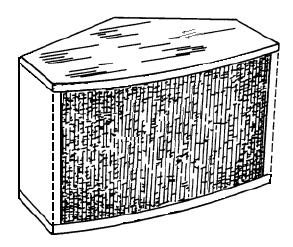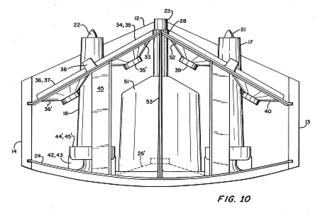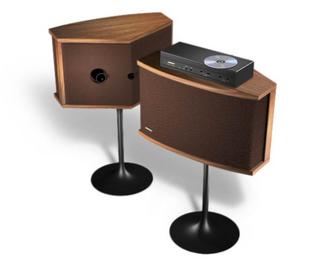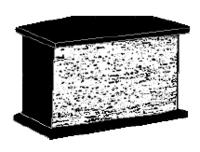TTAB Affirms Refusal to Register Bose Speaker Shape (Again)
Bose Corporation hit another dead end in its nearly thirty-year quest to register as a trademark the product configuration shown below for "speaker systems." In re Bose Corp., Serial No. 74734496 (July 12, 2005) [not citable]. Bose eloquently described the configuration as "an enclosure and its image of substantially pentagonal cross section with a substantially pentagonal-shaped top with a curved front edge parallel to a substantially pentagonal-shaped bottom with a curved front edge."

The Examining Attorney refused registration on, inter alia, the following three grounds: (1) that the subject application (filed on September 26, 1995) is barred by res judicata (claim preclusion) in light of Bose's previous failed attempt to register the same mark for the same goods; (2) that even if claim preclusion does not apply, the proposed mark is de jure functional and unregistrable; and (3) even if registration were not barred under one of the first two grounds, Bose's evidence of acquired distinctiveness under Section 2(f) is insufficient. The Board affirmed the PTO on the first two grounds but, for the sake of completeness, considered the third ground and reversed the PTO's finding regarding acquired distinctiveness.
Res judicata: In 1977, Bose filed Application Serial No. 73127803 for the mark shown below left for "loudspeaker systems." In 1985, the U.S. Court of Appeals for the Federal Circuit deemed that shape to be functional and unregistrable because it was a "superior design." Bose here argued that the factual situation is now different because "the prior adjudication did not include a clear and concise description of the mark limiting the mark to the top and bottom having a curved front edge." Bose also contended that it had not been possible "to state in the prior application that there was no use by others of anything resembling the mark since 1976, a period of nearly 27 years, additional evidence of absence of functionality."
 The Board found the first argument to be "disingenuous" because the curved front edge of the configuration has not changed, even though it was not specifically described in the first application. In fact the Court of Appeals noted that the "front edge is bowed."
The Board found the first argument to be "disingenuous" because the curved front edge of the configuration has not changed, even though it was not specifically described in the first application. In fact the Court of Appeals noted that the "front edge is bowed."As to the second argument, Bose contended that this case should be treated exactly like In re Honeywell, Inc., 8 USPQ2d 1600 (TTAB 1988), in which the Board refused to apply claim preclusion vis-a-vis Honeywell's circular thermostat design due to what had "happened in the marketplace" in the seventeen years after registration was refused. The Board, however, found two important factual distinctions between that case and this: first, the later Honeywell configuration differed from the earlier one; and second, the round thermostat configuration was chosen for source-identifying purposes, whereas here "the pentagonal shape is a clear derivative of the angled rear panels that are integral to the utility patents herein."
De jure functionality: Assuming arguendo that claim preclusion did not apply, the Board found that Bose's product configuration is de jure functional and unregistrable. Applying the time-honored Morton-Norwich factors, the Board saw the most important factor to be the first one: Bose owns two expired utility patents that "repeatedly disclose the utilitarian advantages of this particular configuration."

As to the second factor, Bose's advertisements "tout the utilitarian advantages of the product design."
With regard to the third factor, "the availability to competitors of feasible alternative designs -- i.e., whether the design is superior to other designs," the Board cited TrafFix in asserting that detailed speculation about other designs was unnecessary because "[t]he pentagonal shape ... and the precise placement of the back panels ... are the reasons applicant claims the device works as it does." Bose suggested that the angled back panels could be fitted into, say, a triangular or an octagonal speaker enclosure, but the Board noted that such a design-around "would result in increased costs and major inefficiencies in the manufacturing and shipping processes."
As to the fourth Morton-Norwich factor -- whether the design results from a comparatively simple or inexpensive method of manufacture -- the Board noted that Bose's own utility patent states that the configuration "is compact and relatively easy and inexpensive to manufacture."
The Board concluded that all four Morton-Norwich factors weigh against Bose, and it therefore found the design at issue to be de jure functional.
Acquired distinctiveness: Noting its own determination in 1983 that the Bose design had acquired de facto secondary meaning, and noting that Bose has subsequently racked up twenty-two more years of promotion and exclusive use of the design, the Board reversed the PTO's Section 2(f) determination. Thus if Bose can obtain reversal of the res judicata and functionality rulings, it will be entitled to registration of the subject design.

TTABlog note: Bose's request for reconsideration was denied on October 4, 2005. An appeal to the CAFC was docketed on January 12, 2006 as Appeal No. 06-1173.
TTABlog comment: The Board pointed out in a footnote that Bose owns Registration No. 992,282, issued in 1974, for the pentagonal design shown below for "loudspeaker systems." This design appears to have a straight, rather than curved, front edge. Apparently, the PTO did not deem this design to be de jure functional. One wonders why.

Text Copyright John L. Welch 2005. All Rights Reserved.




0 Comments:
Post a Comment
<< Home